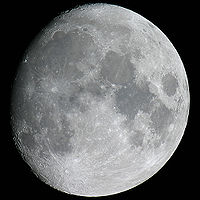More about telescopes on the Moon - this time made of liquid
Thursday, June 19, 2008
Another article today on telescopes on the Moon. The last one was about the possibility to manufacture a mirror in situ on the Moon in order to reduce costs and create a much larger telescope than would otherwise be possible, but the one today is a study about creating mirrors out of liquid. This isn't the first time the subject has come up.
Here's a small quote:
To give an idea how large that is, the largest telescope we have right now on Earth is a binocular telescope with each mirror 8.4 metres in diameter. A telescope on the Moon would have no atmosphere to deal with either of course, and could observe for 14 days at a time as that's how long it takes for night to turn into day again. In LEO there are always frequent sunrises.We have studied the feasibility and scientific potential of zenith observing liquid mirror telescopes having 20 to 100 m diameters located on the moon. They would carry out deep infrared surveys to study the distant universe and follow up discoveries made with the 6 m James Webb Space Telescope (JWST), with more detailed images and spectroscopic studies. They could detect objects 100 times fainter than JWST, observing the first, high-red shift stars in the early universe and their assembly into galaxies.
We explored the scientific opportunities, key technologies and optimum location of such telescopes. We have demonstrated critical technologies. For example, the primary mirror would necessitate a high-reflectivity liquid that does not evaporate in the lunar vacuum and remains liquid at less than 100K: We have made a crucial demonstration by successfully coating an ionic liquid that has negligible vapor pressure. We also successfully experimented with a liquid mirror spinning on a superconducting bearing, as will be needed for the cryogenic, vacuum environment of the telescope.
The pdf can be downloaded here.








0 comments:
Post a Comment